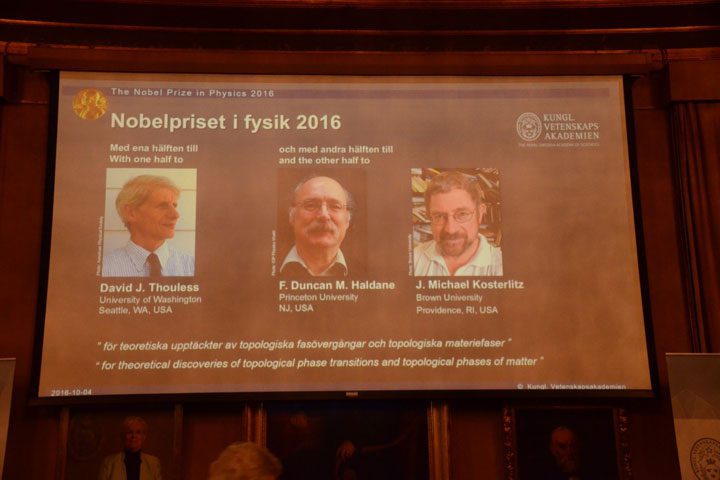The first week of October 2016 observed one significant phenomenon in Physics – when the Royal Swedish Academy of Sciences decided to award the Nobel Prize in Physics 2016 to three British-born scientists for their theoretical work on an unknown world, where matter exists in strange states.
The Nobel Prize for Physics 2016 was awarded with one half to David J. Thouless from the University of Washington, Seattle and the other half, jointly to F. Duncan M. Haldane, Princeton University and J. Michael Kosterlitz, Brown University. To define the subject of their research in the most incoherent form, the three scientists contributed immensely by working on the theoretical discoveries of the topological phase transitions and topological phases of matter. Baffled by the monstrosity of those phrases? Fret not! The next few paragraphs shall be invested in their explanation.

Defining topology
The three Laureates essentially used advanced mathematical techniques to delve into a world where matter exists in unusual states. These phases, like superconductors, superfluids or thin magnetic films exhibit some bizarre properties at cold or condensed states. The math behind Topology explains these characteristics. For example, why super-cold materials conduct electricity without resistance. Topology is a branch of Mathematics which attempts to study the characteristics of objects when they are twisted, stretched or deformed. Using Topology as a tool, the Nobel prize Laureates could demonstrate a ground-breaking concept that in turn shall become the root of most future applications in material sciences and electronics. Thors Hans Hansson, a Nobel committee member who described their work at the Nobel Announcement, said, “It has combined beautiful mathematics and profound physics insights, and achieved unexpected results that has been confirmed by experiments.”
Tracing the timeline of advancements
In the early 1970s, Kosterlitz and Thouless identified a novel type of phase transition in 2D systems. They then disproved the then current theory that superconductivity and super fluidity could not be present in thin layers. The fact that superconductivity could occur at low temperatures and disappears at high temperatures was described using the mechanism of phase transition. This theory applied to certain types of magnets and to superfluid and superconducting systems. It was also an essential part in the elucidation of the quantum theory of 1-dimensional systems at very low temperatures.
In 1980s, Thouless and Haldane developed theoretical methods to describe phases of matter which cannot be identified by their pattern of symmetry breaking. Thouless was then able to explain the quantum Hall Effect in a thin sheet using topological invariants. To break down the quantum Hall effect in simpler words, let us first explain the classical Hall Effect. In a sheet of metal that has voltages applied across the top and the bottom of its surface, one can safely expect an electric current to flow through the sheet. This will then create a magnetic field perpendicular to the sheet which exerts a force on the electrons and drives them away from the top and the bottom, towards the left and right edges. This then creates a voltage drop across the left and the right edges, which is defined as Hall Voltage.
The Hall Quantum effect replaces the metal sheet with a conductor of thickness equivalent to the diameter of a single atom, which has been cooled down to a temperature near absolute zero. In such a scenario, the ratio of the current passing through the sheet and the Hall Voltage created remains constant, irrespective of the material. Thouless used Topology to explain the above concept. Let us take for instance a donut and a bagel. To a topologist, these are the same ‘topological invariant’ of one hole and will exhibit similar topological characteristics. Using Topology as the underlying concept, Thouless explained how conductance was precisely measured as integer steps in extremely thin electrically conducting sheets. He showed that these integers were topological in their nature. Meanwhile, Haldane applied the principles of topology to explain properties of chains of small magnets found in some materials. Haldane also applied the concept of topology to predict that the quantum Hall effect should exist regardless of a magnetic field in some materials. This was shown to be true by other researchers in 2013.
Simplifying the concept
To explain it to the non-erudite fraternity, Hansson brought along a bun, a bagel and a pretzel to the event. He said that a bun with zero holes, a bagel with one and a pretzel with two will be the same even if stretched or twisted. There is no concept of half a hole and you cannot create one. This defines Topology in layman terms and states the fact that topological objects can contain one, two or three holes but the number of holes always has to be an integer. This is precisely how electrical conductance in the quantum Hall Effect was described as the change in voltage steps have to be exact multiples of an integer.
Future scope
Topology and its extensions as a theoretical tool enabled Thouless, Haldane, and Kosterlitz to explicate mysteries like how films of helium at very low temperatures change their state of matter. It also explained how these changing phases correspond to changing electrical and magnetic characteristics. The theory has also translated to practical discoveries in the way that scientists have now developed new materials with these novel characteristics. ‘Topological insulators’ are materials that conduct electricity solely on their surface. One of these insulators, called Stanene is a one-atom thick layer of tin and can conduct electricity at high temperatures with little resistance. Although such materials have not hit the commercial sphere, scientists hope they will soon replace more common metals like copper in the world of electrical devices and electronics.